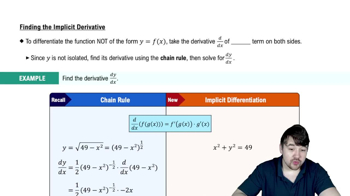Table of contents
- 0. Functions7h 52m
- Introduction to Functions16m
- Piecewise Functions10m
- Properties of Functions9m
- Common Functions1h 8m
- Transformations5m
- Combining Functions27m
- Exponent rules32m
- Exponential Functions28m
- Logarithmic Functions24m
- Properties of Logarithms34m
- Exponential & Logarithmic Equations35m
- Introduction to Trigonometric Functions38m
- Graphs of Trigonometric Functions44m
- Trigonometric Identities47m
- Inverse Trigonometric Functions48m
- 1. Limits and Continuity2h 2m
- 2. Intro to Derivatives1h 33m
- 3. Techniques of Differentiation3h 18m
- 4. Applications of Derivatives2h 38m
- 5. Graphical Applications of Derivatives6h 2m
- 6. Derivatives of Inverse, Exponential, & Logarithmic Functions2h 37m
- 7. Antiderivatives & Indefinite Integrals1h 26m
- 8. Definite Integrals4h 44m
- 9. Graphical Applications of Integrals2h 27m
- 10. Physics Applications of Integrals 2h 22m
4. Applications of Derivatives
Implicit Differentiation
Problem 3.8.23a
Textbook Question
13-26 Implicit differentiation Carry out the following steps.
a. Use implicit differentiation to find dy/dx.
³√x+³√y⁴ = 2;(1,1)
 Verified step by step guidance
Verified step by step guidance1
Start by differentiating both sides of the equation with respect to x. The equation is \( \sqrt[3]{x} + \sqrt[3]{y^4} = 2 \). Remember that \( y \) is a function of \( x \), so when differentiating terms involving \( y \), use implicit differentiation.
Differentiate \( \sqrt[3]{x} \) with respect to \( x \). This is \( \frac{d}{dx}(x^{1/3}) \), which results in \( \frac{1}{3}x^{-2/3} \).
Differentiate \( \sqrt[3]{y^4} \) with respect to \( x \). This requires the chain rule: \( \frac{d}{dx}(y^4)^{1/3} = \frac{1}{3}(y^4)^{-2/3} \cdot 4y^3 \cdot \frac{dy}{dx} \).
Set the derivative of the left side equal to the derivative of the right side. Since the derivative of a constant (2) is 0, you have: \( \frac{1}{3}x^{-2/3} + \frac{4}{3}y^{3}(y^4)^{-2/3} \cdot \frac{dy}{dx} = 0 \).
Solve for \( \frac{dy}{dx} \) by isolating it on one side of the equation. This involves algebraic manipulation to express \( \frac{dy}{dx} \) in terms of \( x \) and \( y \).
 Verified video answer for a similar problem:
Verified video answer for a similar problem:This video solution was recommended by our tutors as helpful for the problem above
Video duration:
4mPlay a video:
Was this helpful?
Key Concepts
Here are the essential concepts you must grasp in order to answer the question correctly.
Implicit Differentiation
Implicit differentiation is a technique used to differentiate equations where the dependent and independent variables are not explicitly separated. Instead of solving for y in terms of x, we differentiate both sides of the equation with respect to x, treating y as a function of x. This method allows us to find the derivative dy/dx without isolating y.
Recommended video:

Finding The Implicit Derivative
Chain Rule
The chain rule is a fundamental principle in calculus that allows us to differentiate composite functions. When applying implicit differentiation, the chain rule is essential for differentiating terms involving y, as we must multiply by dy/dx when differentiating y with respect to x. This ensures that we account for the relationship between x and y in the differentiation process.
Recommended video:

Intro to the Chain Rule
Evaluating Derivatives at a Point
After finding the derivative dy/dx using implicit differentiation, we often need to evaluate it at a specific point, such as (1,1) in this case. This involves substituting the x and y values into the derived expression for dy/dx to find the slope of the tangent line at that point. This step is crucial for understanding the behavior of the function at specific coordinates.
Recommended video:

Critical Points

 5:14m
5:14mWatch next
Master Finding The Implicit Derivative with a bite sized video explanation from Nick
Start learningRelated Videos
Related Practice


